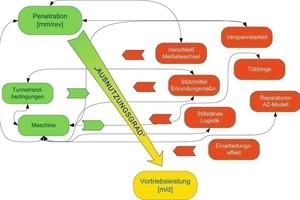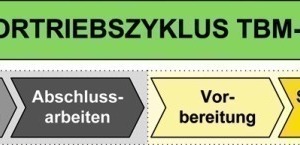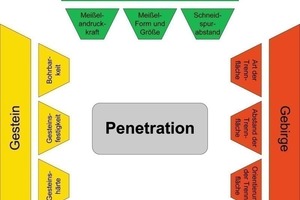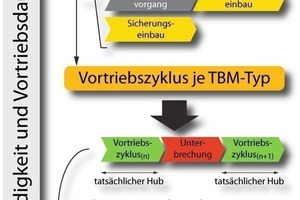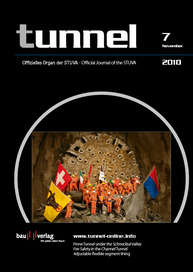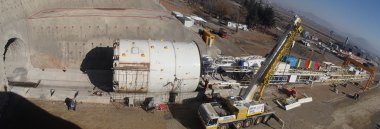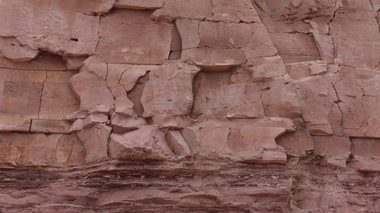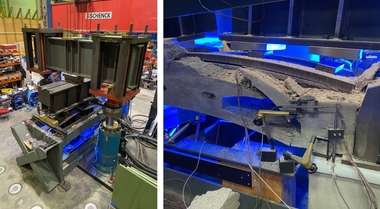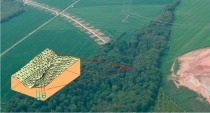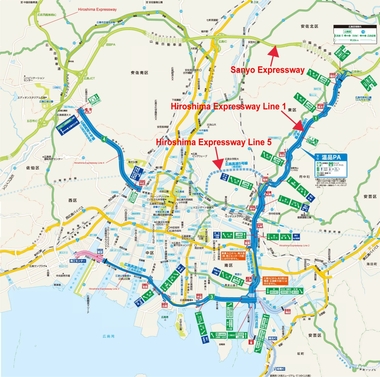Penetration, cutter wear and rate of advance for TBM operations in hard rock
Productivity forecasts are an essential basis for determination of costs and operational planning in construction projects. In tunnel-ling, tunnelling rate which, due to its physical dimension [m/d], is correctly referred to as „rate of advance“ in Austrian underground engineering standards, is the decisive productivity variable. The following examines the potentials for corresponding forecasting.
1 Introduction
The most accurate possible forecast of rate of advance is of great importance in early project phases, particularly in the case of long tunnels. As project implementation draws nearer, precise planning of the operational sequence begins to become ever more important for the client, and necessitates an even more accurate forecast of rate of advance. For the contractor, rate of advance is a decisive input factor for bid calculation and for estimation of the completion-time risk.
In the case of conventional tunnelling (referred to in Austria as cyclical tunneling in accordance with ÖNORM B2203, Part 1), a tried and proven procedure for calculation of rate of advance, the results of which generally fall within an acceptable bandwidth, has become established, in the form of calculation via the cycle time. In the case of TBM-based tunnelling (referred to in Austria as continuous tunnelling in accordance with ÖNORM B2203, Part 2), no standard calculation procedure has up to now become established.
As can be observed from bids submitted, the rates of advance predicted by bidders in some cases diverge greatly. The same is also true of the rates of advance actually achieved, which frequently deviate significantly from the forecast figures. This situation, criticized by Lok Home (president of The Robbins Company, USA) in his words, „Tolerance of inaccurate estimations is hurting our industry“ [1] is most unsatisfactory for all those involved in the project. The causes of this situation are investigated below, and a calculation procedure which produces better results is examined.
2 Basic principles
It is necessary, in order to calculate tunnelling rates for tunnel boring machines (TBMs) in a given geology, to determine penetration, expressed in mm of advance per rotation of the cutter head.
The first step produces net boring speed, stated in m/h. To obtain this, penetration is multiplied by the speed of rotation of the cutter head - stated in revolutions per minute (rpm) - multiplied by 60 (seconds) and divided by 1000 (mm).
The next calculation operation, which leads from net boring speed to rate of advance, must take account of obstructions, faults and interruptions to tunneling. In many cases, this is accomplished by multiplying net boring speed by a utilization factor [%], and in more precise calculation, by means of the assumption of downtimes in minutes or hours.
Tunnelling time, i.e., the working time available for tunnelling, is another factor which must be included in the calculation. This, naturally, is a maximum of twenty-four hours per working day. Tunneling time is correspondingly lower in cases in which a regular maintenance shift is scheduled, or where the working-hours model does not permit 24 h operation.
In strata containing a high abrasive-minerals content, cutter wear also plays a role which should not be underestimated, at least in large-bore tunnels, since the tunnelling time available is automatically reduced as soon as the time available during the maintenance shift is no longer adequate for performance of all the necessary cutter changes. This situation becomes even more critical if it is necessary to change additional cutters during tunneling time.
In the case of open TBMs, the quantity and type of the support systems to be installed in Work Zone A1 immediately behind the cutter head also have a significant influence on rate of advance. Shotcreting in this zone, for example, virtually always necessitates interruption to the tunnelling cycle, whereas rock bolts, steel mesh and steel arches can largely be installed simultaneously to tunnelling advance.
In addition, various machine, operational, logistical and organizational boundary conditions must also be taken into account in calculation of rate of advance. Quantitative inclusion of all these parameters, interdependencies, feedback interactions and influences is not entirely simple and is possible only in the context of a complex computation model, since multiple iterations are necessary in many cases. Fig. 1 illustrates the correlations.
In practice, simplifying computation models, which take account only of the most essential correlations, are generally used for calculation of rate of advance. In addition, there are also many projects for which not all the characteristics data necessary for precise calculation of penetration are available. Experienced users, and contractors active in machine tunneling, in particular, are in most cases able to make good these deficiencies with their experience. This involves a high level of risk, however, in view of the critical influence of rate of advance on excavation costs and on time-dependent site over heads, and also due to the fact that rate of advance must, in many project contracts, be guaranteed by the contractor, or is, at the least, subject to liquidated damages clauses via the agreed milestones. Stimulated by analysis of a large number of TBM projects, and motivated by the desire to find a better solution to a task which has, up to now, been solved only unsatisfactorily, the authors have developed a new model for the calculation of rate of advance and, for this model, software which takes due account of the complex correlations and relieves users of the complicated calculation procedures and multiple iterations otherwise necessary.
3 The current state-of-the-art
There is a large number of models, of differing conception and based on differing experience, for forecasting of penetration. The best known of these are (in order of the year of the most recent publications) the CSM model (Colorado School of Mines, 1993), the Gehring model (Karl-Heinz Gehring is the former head of R&D at Voest-Alpine Montantechnik, Zeltweg, Austria; 1995) and the NTNU model (Norges teknisk-naturvitenskapelige universitet i Trondheim, Norway; 1998). These are used individually, and also, in some cases, in combination (as in the case of E. Büchi, for instance, which utilizes the CSM model as the basis, combining it with elements of the NTNU model, in order to take anisotropy and the cleavage plane structure of the rock into account [2, 4]). The manufacturers of TBMs, and many experts, too, also use their own and modified standard calculation procedures, these being published only in rare instances. None of these models, which were developed primarily for prediction of penetration, includes for calculation of rate of advance any procedure which would satisfy the requirements outlined above. On the contrary, they are restricted, in the main, solely to determination of penetration; the standard models also include concepts for the calculation of tool wear.
Various authors – including Barton [3] – state correlations between net boring speed and rate of advance based on empirical data, however. In his dissertation [4], in which he developed the currently applicable version of the NTNU forecasting model for penetration and cutter wear, A. Bruland outlined a method for derivation of rate of advance from net boring speed by means of a universal „utilization factor“. Information on utilization factors can also be found in other authors, such as M. Alber [5], for example, who states utilization factors as a function of the stability of the rock.
4 Proposals for improvements
The current customary practice of modeling TBM tunneling operations as semi-continuous processes and calculating rate of advance from penetration and daily working time, taking account of utilization factors, and possibly refined via the inclusion of separate terms for gripper setting times, segmental-support installation times, and other interruptions, provides only an imperfect replica of reality.
It is much more accurate to take into account when calculating rate of advance the fact that TBM tunnelling is not a continuous or continuously operating process, but is, instead, always and in every case, i.e., irrespective of the type of machine, an intermittent, i.e., cyclically operating process. This is particularly well illustrated in Fig. 2, which shows a tunneling operation using a simple shield and trailing segmental-support installation (the two main working operations of tunnel boring and support installation follow one another in sequence).
This modeling concept makes it possible to take account directly, and with inclusion of causes, of interruptions and downtimes in calculation of cycle time. The fact that individual working operations can be stated in minutes signifies that a detailed TARGET/ACTUAL assessment of stoppages and downtimes is also possible. This is of significantly greater informational value than a TARGET/ACTUAL comparison of total times and/or total utilization factors, which would supply no information on the causes of the deviation.
The operational processes of machine tunnelling were first comprehensively analyzed and modeled using this concept by W. Leitner. The introduction of the „theoretical excavation rate“ aid, to which downtimes and other outages could be assigned, enabled Leitner to develop a consistent and coherent mathematical solution; inclusion of the boundary conditions is then accomplished in multiple iterations. He elaborated in his dissertation [6] corresponding algorithms for the TBM-O, TBM-S and TBM-DS machine types used in solid rock. This model provided the basis for programming of the software examined in Section 7.
5 Calculation of penetration
Penetration must be calculated as an initial step in the calculation of rate of advance. Penetration (Fig. 3) depends on the three central factors of machine, rock and rock mass, and their interactions.
5.1 Standard models
The examination in more detail of the advantages and disadvantages of the standard models for forecasting of penetration, not to mention the - well over a dozen - other models not explicitly cited here, would exceed the scope of this article. A factor common to all these models is the fact that they are based to a significant extent on the evaluation of data obtained from completed projects. The data-basis used is therefore of critical importance. In the case of the CSM model, these are primarily data from TBM tunnelling projects in North America, in the case of Gehring, data from TBM tunnelling projects in South Africa and South Korea, and data obtained from the relevant literature, while the NTNU model uses data from tunnelling projects implemented in Scandinavia and abroad but with Scandinavian involvement, and still other projects for which data was available to NTNU.
A new chapter in hard rock tunnelling began, at the latest, with the start of machine tunnelling operations in the context of the AlpTransit projects in Switzerland. It was therefore a logical step to utilize the data from these and other major transport-infrastructure tunnels completed using machine methods in the Alpine region since 1990, or scheduled for implementation in the next few years, for improvement of an existing or development of a new model. Also definitive in the decision to attempt such an undertaking was the fact that the majority of tunnels completed prior to 1990 had bore diameters of < 6.0 to 7.0 m, whereas road and rail tunnels necessitate a tunnelling diameter of not less than 9.0 m, even in case of reversing one-way traffic flow. Developments in machine technology - the diameter of and material used for the disks, cutter head geometry and support, infinite speed adjustment, etc. - in the intervening period also make many forecasting models effectively obsolete. There has, in principle, been continuous development and refinement only in the case of the NTNU model, and even here the data material forming the basis for the 1998 version is today more than fifteen years old.
5.2 Development of a new model
To provide a remedy for this deficiency, E. Schneider, after intensive preparatory work, set up in 2006 the „ABROCK - Analysis and Prediction of Penetration and Cutter Wear“ project [7]. Five renowned university institutes from the Alpine region allied to form a research consortium, in order to develop a new model for forecasting of penetration (see table).
The teams from the university institutes received support from industrial partners - project clients, engineering consultancies, contractors and TBM experts. Known correlations were to be verified, and new ones - such as those between penetration and energy of destruction, for example - investigated in more detail, by means of laboratory tests on rock samples, which were performed, primarily, at the Technical University of Munich, and cutting tests using a linear-cutting machine, which is available at the Montan-
universität Leoben (Leoben University of Mining and Technology). Fundamental investigations into „fracture under dynamic load“ are to be performed at the EPF Lausanne. The series of tests are being underpinned and supported by means of numerical models and simulations. The influence of the stress state prevailing in the rock mass on the extraction process is under investigation at the ETH Zurich.
At the University of Inns-bruck, geological and geotechnical data, and also operating data obtained from completed TBM tunnelling projects, are being fed into the Gehring model [8], with subsequent investigation of whether the accordance between theoretical (calculated) and measured penetration can be improved by varying the approaches used in the model or via the introduction of new and/or additional influencing factors. Also under investigation in Innsbruck is the question of whether it might, under certain circumstances, also be possible to use the GSI (Hoek-Brown) in place of multiple individual parameters in a forecasting model for the characterization of rock and rock-mass properties. This would be of particular interest for projects for which no, or only few, laboratory tests have been performed for determination of rock characteristics.
5.3 Tool wear
As already mentioned, the standard models for forecasting of penetration also include modules for prediction of tool wear. In this area, too, there is also need for improvement, since the algorithms contained in these modules were obtained from regression analyses also based on „old“ data material, as indeed was noted some good time ago by one of the authors [9]. Initial insights have already been gained by means of evaluation of more recent tunneling projects in the context of the ABROCK research project, and are to be published in the near future [10]. Specific proposals for improvements may be anticipated as the project proceeds.
6 Calculation of rate of advance
In this calculation step, which progresses from penetration to rate of advance, it is necessary to take into account not only operational, organizational and logistical influences, but also those machine parameters and boundary conditions which have not been included in calculation of penetration. These are, essentially:
- Cutter head speed
- Available torque as a function of speed
- Maximum available/permissible speed of the thrust cylinders
- Maximum permissible disk penetration depth
- Maximum permissible disk wear
- Maximum permissible/available cutter head thrust
- Maximum permissible/available disk cutter cutting thrust
- Minimum necessary cutting thrust per disk cutter
- Maximum conveying rate of the TBM conveyor
The optimization of tunnelling accomplished in practice by machine operators by means of continuous balancing of cutting thrust and speed must also be incorporated into the calculation. Not only the direct influence of the rock and the rock mass, which must be taken into account in calculation of penetration, but also the indirect influence of the rock mass resulting from installation of support, must be included in calculation of rate of advance. The corresponding operational parameters are the support-installation times in Work Zone A1 in the case of open machines, and times for support-ring installation in the case of segmental support systems.
As already mentioned, cutter wear is yet another factor which is capable of exercising a significant influence on rate of advance in the case of tunnelling operations in abrasive rock types. The available tunnelling time is reduced if it is necessary to change more cutters than is possible during the maintenance shift scheduled for this purpose. Unscheduled cutter changing during tunnelling causes further losses of operating time.
Other productivity-determining parameters which must be taken into account are
- the capacity of the system for removal of the excavated material
- the capacity of the logistical system as a whole and, in the organizational sphere
- Planned/available tunnelling time per working-day
- Working-days per month/per year
- Losses of productivity resulting from the „familiarization effect“.
This list, which makes no claim to completeness, should nonetheless suffice to illustrate that calculation of rate of advance using a „simple Excel sheet“ will scarcely be possible. For this reason, SimTunnel, a software package programmed in Java, was developed at the University of Innsbruck in 2005 on the basis of the dissertation by W. Leitner already mentioned (a summary can be found in [11]) in the context of the „TISROCK – TBM Tunneling in Squeezing Rock“ research project. This program, including the specimen calculation for TBM tunnelling projects simultaneously jointly developed with the AUER Success software publisher, was distributed at that time as so-called Free-ware.
7 Reprogramming of the SIMTUNNEL software
Since the initial version did not meet the requirements of users in all respects, and also did not take account of all boundary conditions, the program was completely rewritten in 2009. SIMTUNNEL PRO 2.0 was programmed in MATLAB, a programming language which made it possible to implement the algorithms and correlations better (Fig. 4).
This software includes the following features:
- A standard setting for all values (these can, but need not, be modified by the user)
- Facility for performance of the calculation using only approximately defined figures (rock characteristics data, machine parameters and operational data)
- Integration of a module for calculation of penetration and wear; optionally Gehring, NTNU or CSM; also with individual modifications
- Account can be taken of all working-time and shift models
- Account taken of the „learning curve“ via modeling of the familiarization effect, as per Wachter [12]
- Central input table for all data (rock, rock mass, TBM, operation, etc.)
- Entry of shut-downs, classified into scheduled shut-downs (e.g. maintenance shift, cutter head inspection, etc.)
- system-related shut-downs (e.g. changing of the back-up train, extension of the conveyor, etc.)
- random shut-downs (e.g.repairs, outages, etc.)
- Presentation of results in the form of a standardized report
- an operating schedule in various graphics and vector formats
- AutoCAD script files
The tunnel can be subdivided into any required number of homogenous or tunneling sectors for the purpose of the calculation. These can be calculated individually in each case, in which context the program‘s copy function provides useful assistance. Further subdivision into tunnelling-method classes, as may be necessary in the case of tunnelling using the TBM-O, is also possible. Input of parameters, and the calculation, are performed section-by-section. The results are presented section-by-section and also in summarizing form, and averages are automatically generated and displayed.
Deterministic calculation supplies well-defined figures for rate of advance, tunnelling time and number of cutter changes. Probabilistic calculation produces distribution functions for rate of advance, tunnelling time, cutter changes, etc., complete with statement of most probable values, fractiles, etc.
A standardized technical report in MS-Word is outputted as the computation result, plus a tunnelling schedule in the form of a graphics file or in vector format (time-distance diagram) and pie charts for various activities. The view shown can be both all-encompassing, from Portal A to Portal B, and also subdivided by tunneling sections or homogenous sectors.
8 Summary
There are tried and proven models for calculation of penetration. The input data used for them are no longer up-to-date, however, since they are relatively old and in most cases originate from tunnels with diameters of < 6.0 to 7.0 m. There has, in addition, been considerable progress in tunnelling tech-
nology since 1990, particularly in the cutting tool sector (the material, geometry and diameter of the cutting discs). The modified starting situation was the occasion taken by a group of researchers from five university institutes to take up the
topic of Analysis and Forecasting of Penetration and Cutter Wear, with the aim of developing a new and improved forecasting model. The activities involved include not only the evaluation of tunnelling data, but also, to an intensified degree, fundamental research.
Penetration is, however, only one – although, indeed, the essential – input variable, for calculation of rate of advance. Advance calculation of rate of advance is essentially an operational task, in which machine, operational, organizational and logistical aspects must be taken into account. This is not feasible using a simple, „straightforward“ calculation. It is possible to take account of all boundary conditions and correlations only in multiple iterations.
During 2009 and 2010, a software package which permits in verifiable form computation of rate of advance, taking account of all known influencing factors and boundary conditions, was developed, on the basis of preliminary work performed at the University of Innsbruck, by an engineering consultancy, specializing in
operational matters (SSP BauConsult, Ingenieurbüro für Baubetrieb und Bauwirtschaft, Innsbruck, Austria).

